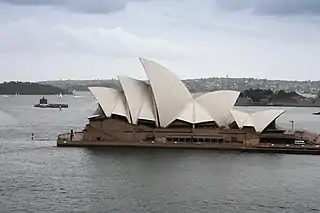Davis Hughes
Sir William Davis Hughes (24 November 1910 – 16 March 2003) was an Australian politician. He was notable for his involvement in the controversial resignation of architect Jørn Utzon from the Sydney Opera House project in 1966.
Hon. Sir Davis Hughes | |
|---|---|
| Minister for Public Works | |
| In office 13 May 1965 – 17 January 1973 | |
| Premier | Robert Askin |
| Preceded by | Norm Ryan |
| Succeeded by | Leon Punch |
| Constituency | Armidale |
| Personal details | |
| Born | William Davis Hughes 24 November 1910 Launceston, Tasmania, Australia |
| Died | 16 March 2003 (aged 92) Erina, New South Wales, Australia |
| Political party | Country Party |
| Spouse(s) | Joan Johnson (1940–2003; his death) |
Early life
Hughes was born in Launceston, Tasmania and was educated at Launceston High School and the University of Tasmania, although he did not graduate.[1] He married Joan Johnson in 1940 and they had one son and two daughters. He was a school teacher in Tasmania from 1927 until 1935, at Caulfield Grammar in Melbourne, from 1936 until he enlisted in the Royal Australian Air Force (RAAF),[2] and at The Armidale School from 1947 until 1950. He served in the RAAF from 1939 until 1945, achieving the rank of squadron leader.[3]
Political career
Hughes was elected as a member of the New South Wales Legislative Assembly for Armidale from 1950 to 1953 and 1956 to 1973 for the Country Party. He was chosen to lead the party in 1958, but his term of office was brief because he was forced to resign in 1959 after it was revealed that he did not have the university degree which he claimed.[4]

With the election of the Askin government in 1965, Hughes became Minister for Public Works,[3] with responsibility for, among other things, the completion of the Sydney Opera House. Hughes refused to accept Jørn Utzon's approach to managing the Opera House project and, specifically, the construction of plywood prototypes for its interiors. Hughes refused to pay a fee claim for £51,000, which meant that Utzon could not pay his staff. After a heated discussion about the claim, Utzon sent a letter of withdrawal to Hughes on 28 February 1966, stating: "You have forced me to the leave the job".[5] In his media announcement made only hours after receiving the letter, Hughes stated it was Utzon's 'resignation'.
The Opera House was completed by another architect, Peter Hall, an ex-government architect from Sydney. Taking on the project, Hall deemed Utzon's seating plan as unsafe, to improve this he subsequently made radical changes to the interior design, a decision that he would be largely criticised for.[6] Despite this, the Opera House was completed under his watch and it eventually opened in 1973.
Upon his resignation from parliament in January 1973, Hughes was appointed NSW Agent-General in London.[7] He died at Erina, New South Wales.
Later life
Hughes died in Erina, New South Wales on 16 March 2003, aged 92.
Honours
Hughes was knighted in 1975, two years after resigning from parliament.[8]
Notes
- "Our History- No 68. Skulduggery in the 1959 State Election". The Armidale Independent. Archived from the original on 27 March 2012.
- Pitt, Helen (15 February 2018). "Barnaby Joyce's seat of New England is no stranger to controversy". Sydney Morning Herald. Retrieved 16 February 2018.
- "Sir Davis Hughes (1910–2003)". Former Members of the Parliament of New South Wales. Retrieved 13 May 2019.
- Farrelly, Elizabeth (1 December 2008). "High noon at Bennelong Point". Sydney Morning Herald. Retrieved 17 October 2013.
- P.Drew, 1999. p.350
- Hassall, Ben Cheshire with Greg; Ricketts, digital producer Kieran (31 January 2016). "The man who fixed the 'plain illegal' Sydney Opera House". ABC News. Retrieved 23 August 2020.
- "Sir Davis Hughes". The Telegraph. 28 April 2003. Retrieved 17 October 2013.
- "Death of the Honourable Sir Davis Hughes". Hansard. Parliament of New South Wales. Archived from the original on 29 September 2007. Retrieved 1 May 2007.
| New South Wales Legislative Assembly | ||
|---|---|---|
| Preceded by David Drummond |
Member for Armidale 1949 – 1953 |
Succeeded by Jim Cahill |
| Preceded by Jim Cahill |
Member for Armidale 1956 – 1973 |
Succeeded by David Leitch |
| Party political offices | ||
| Preceded by Sir Michael Bruxner |
Leader of the New South Wales Country Party 1958 – 1959 |
Succeeded by Sir Charles Cutler |
| Preceded by William Chaffey |
Deputy Leader of the New South Wales Country Party 1968 – 1973 |
Succeeded by Leon Punch |
| Diplomatic posts | ||
| Preceded by Sir John Pagan |
Agent-General for New South Wales 1973–1977 |
Succeeded by Peter Valkenburg |